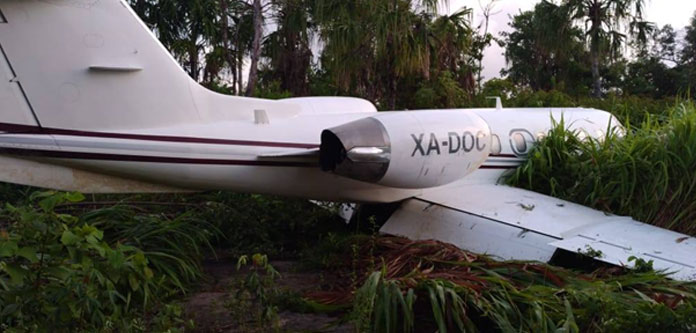SANTA MARTHA, Orange Walk District, Mon. Sept. 21, 2020– Another suspected drug plane was found abandoned this morning on a side road in Santa Martha after it crash-landed near the village at about 1:30 this morning.
Police secured and impounded the plane. A search for the the plane’s cargo and crew was fruitless. Nothing was found except bread and other food items near the plane.
Suspected drug planes continue to elude Belize’s law enforcement because the pilots turn off the transponder onboard the plane, making it very difficult to track them.
In January this year, an agreement was made between the Belize Civil Aviation Authority and INDRA for the procurement of a new primary radar at a cost of BZ$12 million, which would be a great step up from the secondary radar being used in Belize as a primary radar.
Among its many functions, the primary radar would enable Belize law enforcement to more effectively track drug planes even if the transponder onboard the drug plane is turned off.
At the signing of the agreement, General David Jones, security consultant to the Belize Civil Aviation Authority, while briefly outlining to the media the functions of the primary radar, said that all planes have a transponder, an instrument on board that sends out signals.
Planes that are coming in legally turn on the transponder and send signals to Air Traffic Control personnel for instructions to land, and for various other reasons.
Planes entering our air space illegally, however, turn off the transponder. The secondary radar is not capable of detecting such planes, and this is exploited by drug traffickers, but with the acquisition of the primary radar, which has a radius of about 80 miles, any plane that enters our airspace with or without its transponder turned on is immediately detected and tracked.
If an aircraft does not have its transponder turned on, a feed is sent to the Joint Intelligence Command, who will be able to see and track the plane. They can then react quickly to capture the plane before its cargo is removed and its crew is able to escape. It is a major tool to combat the illegal landings of drug planes.
In an interview with Amandala at the Civil Aviation Authority building, Lindsey Garbutt, Director of the Civil Aviation Authority, said that the country would benefit greatly from the acquisition of the primary radar, which should be up and running by September.
The primary radar will be essential, also, in guiding pilots in times of bad weather conditions, which the present secondary radar is not capable of doing, and it would also allow easier control of air movement in the nation’s air space.
The Director gives thanks to the officials of COCESNA and INDRA for their assistance and involvement in acquiring the radar.

